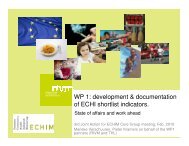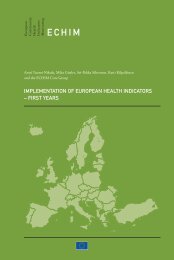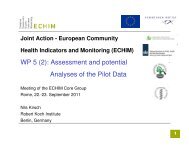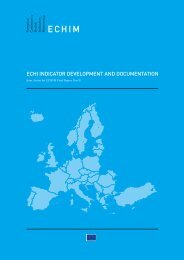INDICATORS
ECHIM Final Report
ECHIM Final Report
Create successful ePaper yourself
Turn your PDF publications into a flip-book with our unique Google optimized e-Paper software.
Calculation:<br />
(1) OECD: The indicator is calculated as the total national health expenditure of a country<br />
in a given year divided by the gross domestic product (as defined by the System of National<br />
Accounts, SNA-93 or ESA-95), expressed in percentages. Calculated and presented<br />
separately for total, public and private sectors.<br />
Total expenditure on health is defined by OECD as the sum of expenditure on activities that<br />
– through application of medical, paramedical, and nursing knowledge and technology – has<br />
the goals of: (1) Promoting health and preventing disease; (2) Curing illness and reducing<br />
premature mortality; (3) Caring for persons affected by chronic illness who require nursing<br />
care; (4) Caring for persons with health-related impairments, disability, and handicaps<br />
who require nursing care; (5)Assisting patients to die with dignity; (6) Providing and<br />
administering public health; and (7) Providing and administering health programmes, health<br />
insurance and other funding arrangements.<br />
(2) The EU Social Protection Committee Indicator “Total health care expenditure as a % of<br />
GDP” (HCP12; 2008), defined as “Total, public and private expenditure on health as % of<br />
GDP”. Recommended source is Eurostat, based on system of health accounts (SHA) data.<br />
Notes: Eurostat, OECD and WHO have adopted a common questionnaire to collect<br />
data on health expenditure, according to SHA methodology. A convergence process of<br />
national health accounting towards SHA methodology has been started. Currently, the<br />
WHO issue data on National Health Accounts, which has been design on the basis of SHA<br />
methodological framework but have some differences.<br />
78. CANCER SURVIVAL<br />
Definition: The relative survival rate for cancer is an estimate of the proportion of patients<br />
who survive at least five years after diagnosis, after correction for background mortality.<br />
The 10 cancers to be included are: 1) all cancers combined without non-melanoma<br />
skin (C00–C97), 2) trachea, bronchus or lung (C33–34), 3) breast (C50), 4) colorectal<br />
(C18–C21), 5) prostate (C61) , 6) stomach, 7) melanoma, 8) cervical (C53), 9) leukaemias/<br />
lymphomas, 10) all childhood cancers (0–14).<br />
Calculation: Relative survival rate is calculated as the observed rate of persons diagnosed<br />
with the cancer in question surviving five years after diagnosis (specific by site, sex,<br />
geographical area, period and age), divided by expected survival rate of a group in the general<br />
population with respect to age, sex and calendar period of investigation.<br />
Notes:<br />
Observed survival rate is calculated as number of persons diagnosed with the cancer in<br />
question surviving five years after diagnosis, divided by number of persons diagnosed with<br />
the cancer in question.<br />
The calculation of a survival rate is complicated by the fact that patients may die of a cause<br />
unrelated to cancer, or may still be alive. Problems of observed survival rate are due to the<br />
fact that not all deaths among cancer patients will be due to the primary cancer in question.<br />
Deaths from other causes lower the observed survival rate, and hamper comparison between<br />
groups for which probabilities of death in the general population vary. To avoid this problem<br />
of comparability, relative survival rates are calculated.<br />
In order to have survival data, Cancer Registries have to collect data on incident cases and<br />
follow-up them for a given period from diagnosis.<br />
130










